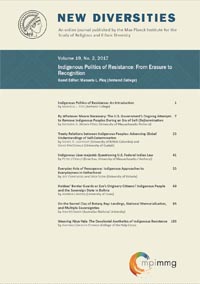On the Sacred Clay of Botany Bay: Landings, National Memorialization, and Multiple Sovereignties
by Ann McGrath (Australian National University)
To cite this article: McGrath, A. (2017). On the Sacred Clay of Botany Bay: Landings, National Memorialization, and Multiple Sovereignties. New Diversities, 19(2), 85–102. https://doi.org/10.58002/v4ze-vy16
To mark the federation of the Australian colonies in January 1901, a re-enactment of the landing of British navigator Captain James Cook was performed at Botany Bay, New South Wales. This involved not only the arrival of Cook’s ‘discovery’ party ashore, but also a violent conflict with the local Gweagal/Dharawal people. The Landing Play brought together costumed professional actors and a troupe of Aboriginal performers from many parts of Australia. As indelible as the Cook landing story may seem as a foundational narrative replete with British flag raising performances, Australia’s national story has never been entirely unified, homogenous or settled. Spectacularly adorned in animal skins and bird feathers, the Indigenous troupe used sacred white clay to paint their faces and bodies in distinctive designs, signifying the deep history narratives of their respective Indigenous nations. Both the European and Indigenous Australian actors re-enacted histories associated with their respective ancestral heroes on lands they deemed sacred. These contested performances of sovereignty, of ‘landings’ and of history, were mutually witnessed and in conversation with each other. Yet, while contemporary politicians and elites were reifying Captain Cook’s legacy, much of the general audience ignored expectations, invading the VIP tent and cheering not the pompous Captain Cook oratory, but the Aboriginal actors who charged and attacked Cook’s party. A Maori Native Affairs Minister from New Zealand and three Maori chiefs watched the 1901 spectacle. In contrast to the Indigenous recognition enjoyed in neighboring New Zealand, the Australian government today continues to resist a constitutionally recognised Indigenous advisory body, let alone to discuss discrete parliamentary representation or a Treaty. Yet then, as now, multiple parallel sovereignties and their sacred histories continue to be enacted and re-enacted across the Australian continent.
Keywords: memorialization, landin, re-enactment, Indigenous sovereignty, Botany Bay, Australia, Captain Cook, sacred places, nationalism, violent conflict, Colonialism
|
